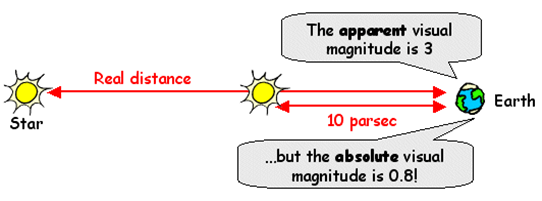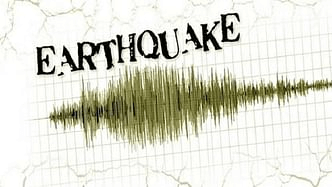Magnitude DefinitionMagnitude is a term used in physics to describe the relative size of a physical quantity. It is typically used to refer to the size of an object or force or the intensity of a phenomenon or event. Magnitude can indicate the absolute or relative size of an object or phenomenon. Magnitude measures the amount of energy, or power, associated with a physical quantity. 
Types of MagnitudeThere are several types of magnitude, each with a different meaning. These include: 1. Absolute MagnitudeAbsolute magnitude measures an object's light from a distance of 10 parsecs (32.6 light-years). The absolute magnitude of an object is calculated from its apparent magnitude and distance from Earth. It is an objective measure of an object's absolute radiance and is used to compare objects of different sizes and distances. 
2. Apparent MagnitudeApparent magnitude measures an object's light as seen from Earth. It is the radiance an object appears to have when viewed from a distance, without considering its distance from us. Apparent magnitude is the most commonly used measure to describe the brightness of an object and is the measure used in star catalogs. 3. Visual MagnitudeVisual magnitude is an astronomical measure of an object's light as seen by an observer's eye. It measures an object an observer sees at a specific wavelength on the electromagnetic spectrum. Visual magnitude is typically measured using a telescope and is expressed as a number on the magnitude scale, with brighter objects having lower numbers. 4. Relative MagnitudeRelative magnitude is the measure of the size of an object relative to another object. For example, if one object is twice as big as another, we can say that the first object has twice the relative magnitude. It can also be used to compare the size of different objects, such as comparing the size of a mountain to the size of a house. Relative magnitude can be used to compare objects of different types, sizes, and shapes. It is important in many fields, such as astronomy, geology, engineering, and physics. 5. Angular MagnitudeAngular magnitude measures how large an angle appears from a given point. It is usually expressed in degrees and is the angle from one point to another, measured in a straight line. Angular magnitude is used to compare the size of an angle and is particularly important in astronomy, where it measures the size of stars and planets in the night sky. Generally, the larger the angular magnitude, the larger the angle, and the more apparent it is when viewed from a given point. 6. Spectral MagnitudeSpectral magnitude measures an object's light in terms of its spectral energy distribution (SED). It is an objective measure of an object's spectral energy distribution and is used to compare objects of different sizes and distances. Spectral magnitude is calculated from an object's absolute magnitude, distance, and spectral energy distribution. 
7. Photographic MagnitudeThe photographic magnitude scale measures the light of stars and other astronomical objects. This scale is based on photographic film's sensitivity, with a magnitude of 12.5 being the faintest objects detectable by photographic equipment. Applications of MagnitudeMagnitude is used in many areas of physics, including astronomy, astrophysics, geophysics, and seismology. In astronomy, magnitude measures the brightness or luminosity of stars and other celestial objects. In astrophysics, magnitude is used to measure the intensity of cosmic background radiation, and in geophysics, magnitude is used to measure the intensity of seismic events. In seismology, magnitude is used to measure the size of earthquakes.
Magnitude Measurement MethodsThere are several ways to measure the magnitude of a star or other astronomical object, including visual, photographic, and spectroscopic methods. 1. Visual Magnitude MeasurementThe visual magnitude of a star or other astronomical object can be measured by comparing its brightness to that of a standard star. This method requires the observer to have a good view of the night sky and a knowledge of the relative brightness of stars. 2. Photographic Magnitude MeasurementPhotographic magnitude is a measure of the brightness of an astronomical object as seen from Earth. It compares the relative brightness of stars, galaxies, and other objects in the night sky. 3. Spectroscopic Magnitude MeasurementSpectroscopic magnitude measures an object's light by analyzing its spectrum. Specifically, the magnitude is determined by comparing the object's spectrum's flux (or intensity) at specific wavelengths to the flux of a reference star at the same wavelengths. This comparison is made by measuring the star's color index, which is the difference in the magnitudes of two bands (usually in the U, B, V, or R passbands). Magnitude CalculationsOnce the magnitude of a star or other astronomical object has been determined, it can be used to calculate its distance from Earth. This is done using a technique known as the inverse square law, which states that the brightness of an object decreases inversely with the square of its distance from the observer. The object's distance can be calculated by comparing its apparent magnitude to its absolute magnitude. Measuring MagnitudeMagnitude is usually measured using a scale, such as the Richter Scale. The Richter Scale is logarithmic, meaning that each point on the scale is ten times more powerful than the one before it. For example, a magnitude six earthquake is ten times more powerful than a magnitude five earthquake and 100 times more powerful than a magnitude four earthquake. In addition to the Richter Scale, other scales are used to measure the magnitude, such as the Moment Magnitude Scale, the Mercalli Intensity Scale, and the Modified Mercalli Intensity Scale. Natural Disasters Measured by Magnitude1. EarthquakesEarthquakes are one of the most common natural disasters, and the magnitude of an earthquake is an important factor in determining its severity and potential damage. Magnitude measures the size of the seismic waves released during an earthquake. Earthquakes of 6 or higher are considered major earthquakes and can cause significant damage. 
2. TsunamiTsunamis are waves caused by underwater earthquakes, volcanic eruptions, or other disturbances. The magnitude of a tsunami is determined by the size of the disturbance that caused it. Tsunamis of 8 or higher are considered major tsunamis and can cause widespread destruction. 3. Volcanic EruptionsVolcanic eruptions can cause significant destruction, and the magnitude of a volcanic eruption can be determined by measuring the amount of ash and lava released. Major eruptions of 6 or higher magnitude can cause widespread destruction and potentially disrupt global climate patterns. 4. Asteroid ImpactsAsteroid impacts are another natural disaster that can have devastating consequences. The magnitude of an asteroid's impact is determined by the size of the asteroid and the amount of energy released upon impact. Asteroid impacts of magnitude eight or higher can cause significant damage and potentially cause global climate change. Other Natural DisastersIn addition to earthquakes, tsunamis, volcanic eruptions, and asteroid impacts, other natural disasters can be measured by magnitude. These include storms, floods, landslides, and more. The size and intensity of the event determine the magnitude of these disasters. ConclusionIn conclusion, magnitude measures the size or intensity of a physical quantity, such as length, area, volume, mass, speed, or temperature. It can also be used to describe the brightness of a star, the intensity of an earthquake, or the size of an object in the universe. Magnitude is typically expressed as a number on a logarithmic scale, each representing a factor of ten. The distance of an object can be calculated from its magnitude. There are several types of magnitude, each with a different meaning. These include absolute Magnitude, apparent Magnitude, visual Magnitude, luminosity magnitude, relative Magnitude, angular Magnitude, and spectral Magnitude. Magnitude is used in many areas of physics, including astronomy, astrophysics, geophysics, and seismology. It measures the severity of natural disasters, such as earthquakes, tsunamis, volcanic eruptions, and asteroid impacts. In addition, magnitude is also used to measure the severity of other natural disasters, such as storms, floods, and landslides. Magnitude is an important factor in determining the potential damage caused by natural disasters.
Next TopicMean, Median, Mode definition
|
 For Videos Join Our Youtube Channel: Join Now
For Videos Join Our Youtube Channel: Join Now
Feedback
- Send your Feedback to [email protected]
Help Others, Please Share










